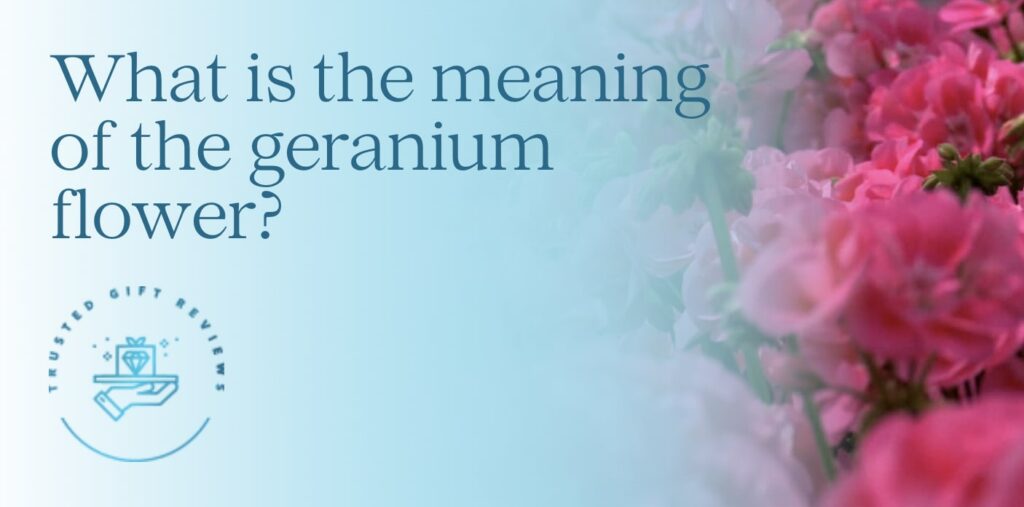Geraniums have plenty of positive meanings, but the most general ones are bliss, love, good health, peace, and friendship. Indeed, these are perfect attributes for their cheerful, clustered, and frilly blooms.
However, they held a negative connotation during Queen Victoria’s reign in England. They represented a person who’s hasty and careless when acting or making decisions.
Now, let’s delve further into the various meanings and symbolisms of geraniums across cultures. We’ll also discuss their associated myths and when it’s best to gift them to a friend or loved one.
Basic Information about Geraniums


Genus: Geranium
Family: Geraniaceae
Native Habitat: South Africa
Growth Behavior: Perennial or annual
USDA Zone: 10 to 11
Geranium is a genus comprising greater than 400 herb species with woody or tuber roots. All of these species belong to the family of Geraniaceae.
Their native habitat is in subtropical areas in South Africa. However, they’re also home and widely grown in Europe, Asia, and Australia.
They can either be perennial or annual, but most are perennials that grow in USDA winter hardiness zones of 10 to 11.
Versatile and simple to care for, geraniums can be planted in garden beds, indoor pots, or outdoor hanging baskets.
Geranium Plant Description


Unlike other flower varieties, geranium plants appear different from each other in bloom, foliage, and root structures.
For instance, the common geranium flower has five similar petals, while pelargoniums have two upper and three lower petals varying in shape and color patterns. Most geranium blooms, however, are shaped like a bell.
Aside from that, these flowers can have single or double blooms that are frilled or ragged. Plus, they’re available in an array of colors—white, hot red, violet, and different shades of pink.
As for the leaves, they’re usually dark green, lobed, and lush, cradling the flower or surrounding it.
And when the plant becomes mature, it can reach a height of 6 to 48 inches tall. So, one can see geraniums standing tall and proud in a garden or a meadow.
Geranium Etymology


Geranium is a modern Latin word derived from the Greek word geranion and the older Greek word geranos, meaning “crane.”
That’s why the flowers are also referred to as crane’s-bill. This describes the geranium flower’s distinct, long, and pointed seed capsules.
Geranium Flowers’ Meaning and Symbolism


As we said earlier, geraniums represent joy, friendship, fortune, good health, and carefreeness. Their showy and lively blossoms suggest these feelings.
- Geranium’s Positive Meanings
Other than that, they mean immortality in China, longevity in Japan, and wealth in Egypt.
The geranium is also associated with saints and gods. In a few religions and cultures, it can mean peace, love, healing, fertility, grace, and devotion.
In fact, it commonly comes up in Christian, Islamic, and Scandinavian texts and traditions.
- Geranium’s Negative Meanings
During the Victorian Era—when Floriography, the language of flowers, became popular—geraniums were attributed negative meanings.
They’ve been taken to mean unoriginality and tastelessness because, during the said era, they were commonplace. A lot of homeowners grew them on terraces.
The flowers’ eye-catching beauty also made them a symbol of envy and deceit. Additionally, the flower can also stand for foolishness.
Geranium Flowers’ Meanings by Color


General meanings aside, the geranium flower’s meaning can also be interpreted by the specific color it has.
Let’s take a look at its typical hues and what they mean.
- Pink Geraniums
Pink geraniums symbolize gentle love and affection. Others view it as a sign of a mother’s love and femininity.
Depending on the shade of pink geraniums you get, these meanings can have a stronger or weaker intensity and delivery.
- White Geraniums
White geraniums express purity, innocence, and elegance. It’s also a timeless symbol of fertility.
White geraniums were also said to be a reliable protection plant, believed to repel certain critters like flies and snakes.
- Violet or Purple Geraniums
Purple (row 289 – purple flowers meaning) or violet is one of the most remarkable colors of geraniums. This color symbolizes class, style, and refinement.
Besides that, violet or purple geraniums beautifully signify admiration or respect for someone. And since their fully bloomed petals look calm and tranquil, they’re also symbolic of comfort and a peaceful state of mind.
- Red Geraniums
Despite their name, red geraniums don’t belong to the genus Geranium but to Pelargonium. Both genera belong to the family Geraniaceae.
Red geraniums are a specially bred cultivar. They can mean deep love and romance.
Wiccan tradition believes that red geraniums placed by the door or doorway can ward off sickness and sense the presence of strangers or thieves.
- Blue Geraniums
Blue geraniums are symbolic of the peace and tranquility of the ocean.
Also, this blue nicely contrasts with the plant’s green, healthy leaves, similar to Mother Earth’s colors. This color pairing gives it the additional meanings of fertility and abundance.
One of the coolest blue geranium varieties is Johnson’s Blue. Blooming from late spring to mid-summer, they’re known for their cluster of lavender-blue flowers and gracefully cut leaves.
- Yellow Geraniums
Friendship and joy are the meaning of yellow geraniums. Seeing them around you is like walking in a ray of sunshine that’s pleasant and warm.
Although rare like blue geraniums, certain gardeners sell them on their website or shop. These cheery blooms can be suitable to place outside the window—great for increasing your curb appeal.
Geranium in Myths and Religion


The geranium is a significant flower in mythology and religion. Let’s now have a look at the instances it appears in sacred texts and stories.
A Symbol of Odin’s Grace
This flower represents Odin’s grace in Scandinavian and German mythologies. Odin is the god of many things, including wisdom, healing, poetry, war, death, and victory.
One of its typical varieties, the Geranium sylvaticum, was also known as Odin’s Favor. And the Geranium pratense or Gratia Dei was Odin’s flower in Iceland, representing the blue eyes and the robe of the god.
Its etymological origin, Gratia Dei was a Latin word translated from the German word Gottes gnade, which means “Odin’s flower” or “Odin’s grace.”
A Symbol of Hope and Safety
This symbol stemmed from an old Greek myth about the flood apocalypse that was to destroy humanity once and for all.
The story goes that Zeus, the sky and thunder god, saw that man had been acting wrongly for some time against his intentions. So, one day he decided to punish them by sending a great flood.
A flock of cranes went to warn Megarus, who was the son of Zeus and the nymph Sithnid. So taking into account the crane’s warning, he went, swam, and climbed toward the top of Mount Geranium, thus keeping himself safe from the disaster.
So you can see how geranium is vital in the story. Curiously, the flower is also called Crane’s-bill, and cranes appear in the myth as a messenger of hope.
Saint Robert’s Geranium
Wherever they reached, Christian missionaries changed native plants’ names into those of Christian saints and martyrs.
So, to this end, they named one flower Saint Robert’s Geranium, from which the binomial name of Geranium robertianum came.
Today, Saint Robert’s Geranium comes in many monikers like Herb Robert, wild geranium, the old maid’s nightcap, and even red robin.
- Symbol of Fertility
Saint Robert’s Geranium has a seed capsule that resembles a stork’s beak, leading people to believe that they can help parents get a baby. In European folklore, storks are said to deliver babies.
In order to signal to the spirits that the couple wishes for a child, they wear Saint Robert’s Geranium amulets or place these flowers under the bed at night.
- Death Come Quickly
Having said that, the flower also had an unfavorable meaning of bad luck and death in West Cumberland, UK.
Children who plucked this flower out of the ground were believed to die soon. And the practical explanation for this is that a snake can hide around the plant’s stems, waiting to pounce on those who come near it.
Sacred Flower of the Prophet Mohammed
There are three different versions of the Islam legend involving geraniums.
One of these depicts the Prophet Mohammed going to the mountain to pray and returning to the valley with his clothes all soaked in sweat. So he decided to take a bath, removed his clothing, hung and let it dry on a simple plant near his tent.
When it has finally dried, he thanked and blessed the plant. And then, suddenly, the plant magically transformed into a beautiful rose geranium.
Geranium Flower to Ward off Evil Spirits


Interestingly, a lot of people in the past believed that geraniums had magical powers.
The leaves of the beautiful and fragrant rose geraniums (Pelargonium graveolens) were brushed off on walls and doorknobs. They believed it protected them against theft and bad intentions.
In addition, geranium roots were worn around the neck to ward off evil spirits and bad luck.
Geranium Flowers in Astrology


Scorpio is the astrological sign most related to geraniums. That’s because they were believed to repel snakes, which matched the traits of Scorpio people—who are strong, brave, and determined.
Also, the astrological sign is represented by the scorpion, which preys on snakes, similar to geraniums. So, one can say that the flowers suggest overcoming temptations or shrugging away the negative energies or attacks of other people.
The Uses and Benefits of Geranium Flowers


Geraniums have several uses and benefits that can make them excellent to have.
- Decor
First, it can be used to add warm and energetic colors to your garden or windowsill. They can be kept indoors to give positive psychic energy and complement your decor.
- Food
Your favorite salad and meal recipes can be garnished with its flowers for added beauty and aroma. Both the flowers and leaves of scented geraniums are flavorful and edible, by the way.
- Medicine
In the field of medicine, geraniums have been traditionally used to improve respiratory ailments, pain, infections, anxiety, depression, and more.
What’s more, geranium oil is a key ingredient in many beauty and skincare products. Applied topically, it can soothe and purify the skin thanks to its anti-bacterial and anti-inflammatory properties.
When to Give Someone a Geranium Flower


- Housewarming
With their leafy growth and sunny blooms, geranium flowers are ideal housewarming gifts to be put outside on the porch or deck. It will make the house look and feel warmer and more jovial.
If you have been invited to a friend or family member’s house, you can also surprise them with a few potted geraniums in a large basket so you can carry them easily.
- Get Well Soon
Geraniums can also be used for wishing someone well. A friend that has been recovering in a hospital can brighten up when seeing these flowers beside their bed or on the nearby table.
However, these aren’t the only occasions you can gift someone these special flowers. For this, consider their colors and match them with their respective events for maximum impact.
For example, a white geranium can be a nice, memorable present for a wedding couple, red ones can convey your love for your spouse or partner, and purple can be given to a senior person or relative whom you admire.
How to Care for Geranium Flowers


Only basic care and maintenance are required for geranium flowers to thrive. Follow these tips below for that:
- Soil
Use moist and well-draining soil for geraniums. The potting mix preferably needs equal amounts of soil, perlite, and peat moss.
- Watering
Watering should be deep and only done when the soil has become dry. Usually, once a week watering will suffice; however, potted plants outdoors may need daily watering in a hot climate.
- Sunlight
Set it in a spot where it can receive bright sunlight for six to eight hours every day. Be aware that they don’t like filtered or shaded areas, which can result in a long and lanky build and less flowering.
Geranium Maintenance
- Space plants around 8 to 12 inches apart to give them space to grow lushly and healthily.
- You can feed them with water-soluble or 5-10-5 fertilizer every four to six weeks throughout their growing season.
- Apply 2 to 3 inches of mulch around geraniums after planting them.
- Deadheading blooms must be done to keep the plant neat and productive as it grows.
More Flower Meaning Guides
In addition to this guide, you may want to check out these flower meaning articles as well:




